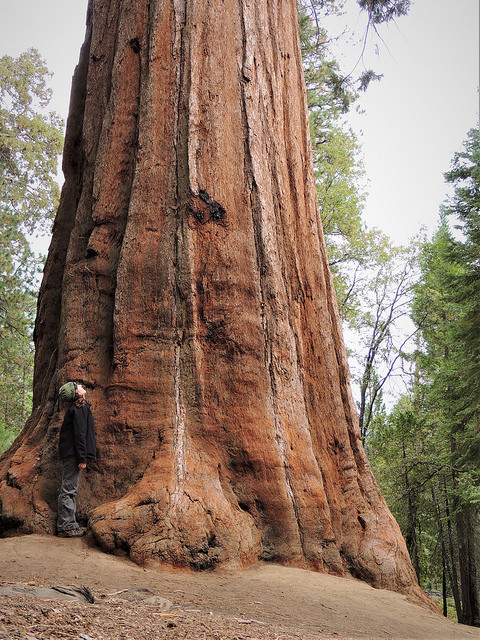It was pointed out to me that I use the word “awesome” quite a bit. At first I was kind of put off, being called out on my lack of mature, diverse vocabulary. I started to think about what the word meant. What is awe?
Awe is a feeling we get when we look at something vast that challenges our understanding of the world. Wonder or amazement could also describe the same feeling. It is the feeling that you get when you look up at a clear, dark night sky, a beautiful sunset, or an expansive view.

Looking up a Sequoia. Photo by Katie Finch
Experiences in nature often create a sense of awe. I recall a trip to Yosemite National Park. Before going, I was concerned I wouldn’t feel awed because all the photos, books, and videos I’ve seen of the place. However, looking out over iconic, granite rock formations that tower thousands of feet over a valley carved by wind and water, I don’t know why I ever doubted. I walked around for days astounded that such a place existed on our planet. And I was able to be there.
Not all that brings us awe is large. Some is quite small. I recall a Ruby-throated Hummingbird nest someone brought to me. In the palm of my hand I held delicately shaped thistle or dandelion fluff wrapped together by spider webs and camouflaged with bits of lichen. These materials deliberately chosen and shaped by a mother to hold her future.
Gone were the birds that hatched out of eggs the size of jellybeans. Light enough to be mailed with a first class stamp, I hoped they were successful in traveling hundreds of miles to their wintering grounds in Central America. And that they make it back in spring, as their instinct demands.
Until recently, awe was the language of religion and philosophy. Only recently has awe been studied by the scientific community. And what they are finding is — ok, I’m going to do it — awesome.
By the very definition, awe is a feeling about something bigger than yourself. Not necessarily in size, like Yosemite Valley. One can be awed at a larger body of knowledge, a larger sense of time, a great feat, or accomplishment.
And seeing something larger than ourselves makes us feel smaller. At first, it doesn’t sound like a good thing — feeling small. But this feeling can put our lives in perspective. It can make us humble. We are small. But a small part of something larger — a group, a community, a country, a planet, a universe.

First robin hatching. Photo by Jeff Tome.
Research shows that awe can move us away from self-interest toward belonging. It can lead us to become more generous. It may even break down the “us versus them” attitude. (For more information, visit The Greater Good Science Center at the University of California, Berkeley at greatergood.berkeley.edu).
Seems intimidating? Equally as awesome, is the idea that awe can be cultivated. I assumed it was just a feeling that came upon you when the right mix of mood, environment and a rare thing aligned. But no. We can practice.
Go outside and take a walk. Notice. And you don’t have to wait to have the time or money to go to other places. Awe is not something limited to a certain social or economic class. Amazing things can be found in the every day. Sometimes, when something is so common, we forget it can be amazing. If it is something commonplace, look at in a new way. Awe, after all, challenges our understanding of the world. When in doubt, hang out with a child. They are often seeing things for the first time. Every worm, colorful leaf, and shiny rock can be wonderful.

The birth of a baby can evoke a feeling of awe. Photo by Katie Finch
Awe is most often felt in the natural world but can also be felt in regards to people. Humans create awe-inspiring works of art, music, architecture. Humans also achieve outstanding feats, overcome seemingly impossible challenges and show enormous, awe-inspiring love. Seek out ways to witness or learn about the things that interest you.
If you are reading this article, chances are you’ve had opportunities to see at least a few amazing things. Image what a child would feel like seeing the night sky for the first time in an area not polluted with light. Or to be seeing a fall forest for the first time in your life. If we don’t revel in what awes us, we miss being a model for others.
Recently, I took teenagers on a camping trip. I worried the endless world of internet and technology coupled with the growing teenage brain had dulled their ability to be amazed. I was honored to show them things — both large and small in size — that evoked awe (even if they didn’t always express it) and to see that sometimes nature is enough.
I have no qualms about saying we live in an awesome world. We can stand in awe of the natural world, human capabilities, and the constantly evolving understandings we have about the connections between the two. We just have to go out and take a look.
Katie Finch is a naturalist at Audubon.
Audubon Community Nature Center builds and nurtures connections between people and nature. ACNC is located just east of Route 62 between Warren and Jamestown. The trails are open from dawn to dusk as is Liberty, the Bald Eagle. The Nature Center is open from 10 a.m. until 4:30 p.m. daily except Sunday when it opens at 1 p.m. More information can be found online at auduboncnc.org or by calling (716) 569-2345.


Recent Comments